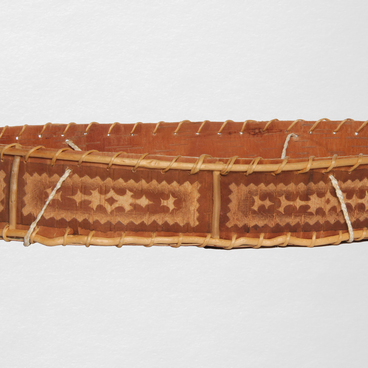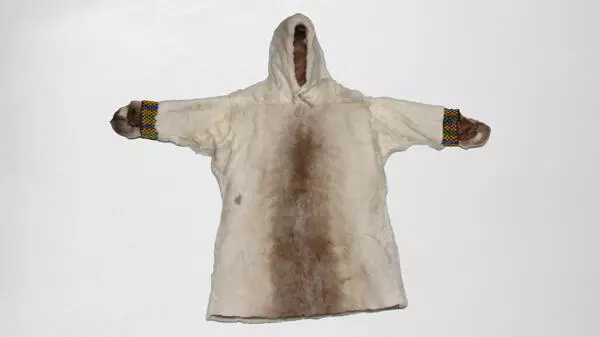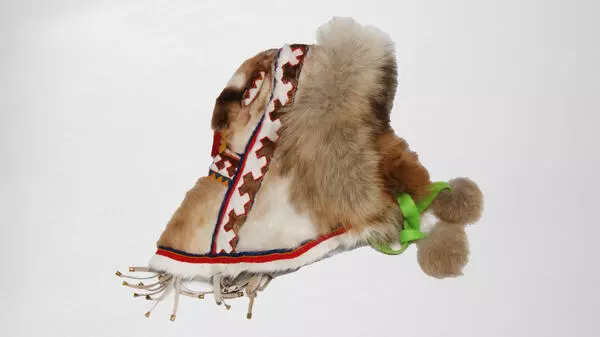The Nguhuko doll was a traditional children’s toy of the Nenets. It was made on the basis of the beak of a waterfowl. For a male doll, a goose’s upper beak was used, for a female doll, a duck’s one, and for a child doll it was the beak of a small bird. Sometimes the beak was used with the remaining plumage from the forehead.
The use of body parts of waterfowl for toys had sacred significance, since these birds were associated with three elements at once: earth, water and air. The Nenets believed that in winter the birds went south to the spirits of their ancestors, and in the spring they returned back to the people. Therefore, they were strong enough to protect the child from misfortunes and evil spirits. At the same time, the Nenets did not depict a face on the Nguukhko. According to popular beliefs, the doll was not supposed to “see”, otherwise it could come to life and take the child’s soul.
The body of a doll about 15–20 centimeters high was created from a piece of fabric — broadcloth. It was wrapped in the form of a skirt around the base of the beak, hemmed and additionally tied to it with a ribbon made of fabric, which depicted a collar.
These dolls, as a rule, did not have limbs. Hands were sometimes designated by sleeves, and legs seemed to be hidden under the wide hem of a dress or fur coat.
Nguhukos were dressed and decorated with fur, beads, multi-colored ribbons from different fabrics. Usually an odd number of ribbons were used; sometimes they were covered with a triangular ornament. Nguhuko from the collection of the museum of the city of Muravlenko is sewn from fabric of two colors — green and red. The patches are separated by beaded embroidery.
In Nenets families, girls began to prepare early for the role of housewives. Making clothes for Nguhukos, under the guidance of their mother or older sister, from the age of five or six, they learned to sew, cut, and select jewelry. Outfits for the Nguhukos were created in the image and likeness of real national costumes.
Over time, the girls had whole doll families — with adults, children and old people. Small plagues, boats, sledges with toy deer and even household items were made for the Nguhukos: dishes made of fish vertebrae or birch bark, axes, fishing nets and so on.
The use of body parts of waterfowl for toys had sacred significance, since these birds were associated with three elements at once: earth, water and air. The Nenets believed that in winter the birds went south to the spirits of their ancestors, and in the spring they returned back to the people. Therefore, they were strong enough to protect the child from misfortunes and evil spirits. At the same time, the Nenets did not depict a face on the Nguukhko. According to popular beliefs, the doll was not supposed to “see”, otherwise it could come to life and take the child’s soul.
The body of a doll about 15–20 centimeters high was created from a piece of fabric — broadcloth. It was wrapped in the form of a skirt around the base of the beak, hemmed and additionally tied to it with a ribbon made of fabric, which depicted a collar.
These dolls, as a rule, did not have limbs. Hands were sometimes designated by sleeves, and legs seemed to be hidden under the wide hem of a dress or fur coat.
Nguhukos were dressed and decorated with fur, beads, multi-colored ribbons from different fabrics. Usually an odd number of ribbons were used; sometimes they were covered with a triangular ornament. Nguhuko from the collection of the museum of the city of Muravlenko is sewn from fabric of two colors — green and red. The patches are separated by beaded embroidery.
In Nenets families, girls began to prepare early for the role of housewives. Making clothes for Nguhukos, under the guidance of their mother or older sister, from the age of five or six, they learned to sew, cut, and select jewelry. Outfits for the Nguhukos were created in the image and likeness of real national costumes.
Over time, the girls had whole doll families — with adults, children and old people. Small plagues, boats, sledges with toy deer and even household items were made for the Nguhukos: dishes made of fish vertebrae or birch bark, axes, fishing nets and so on.








